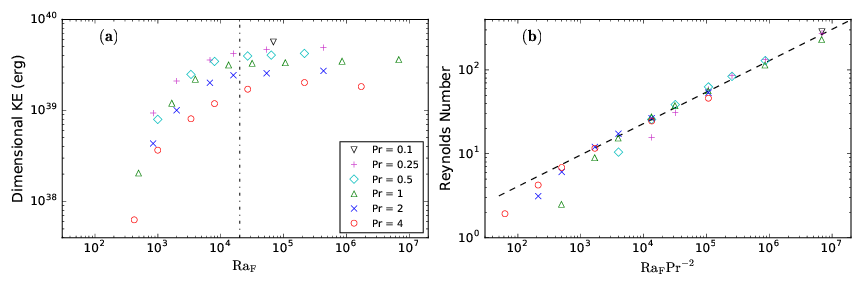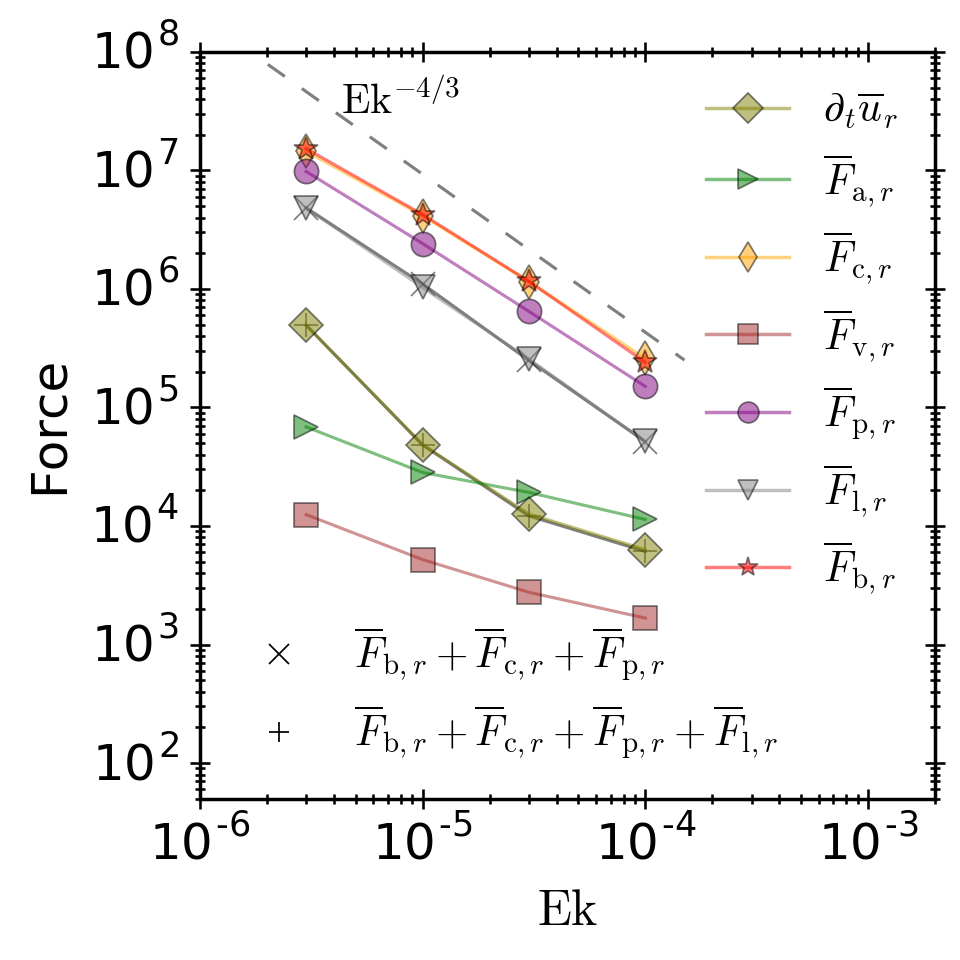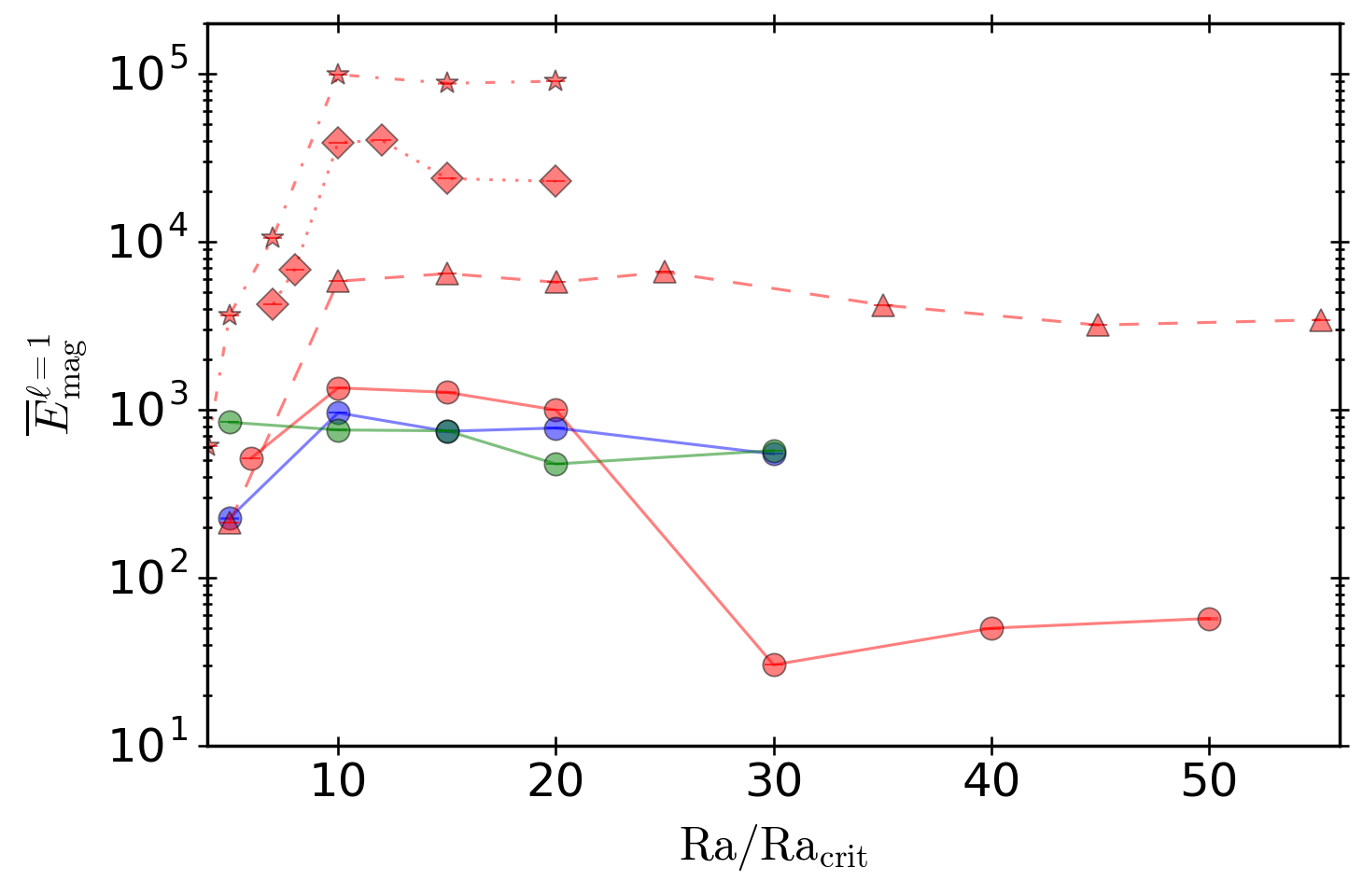The large-scale (mean) force balance in convection-driven dynamos in a spherical
geometry is analyzed, as relevant to the geodynamo. The forces are analyzed with
numerical simulation data and asymptotic theory. In agreement with previous work, the
mean force balance is shown to be thermal wind (Coriolis, pressure gradient, buoyancy)
in the meridional plane and Coriolis-Lorentz in the zonal direction. Particular emphasis
is given to determining the asymptotic size (with the small parameter being the Ekman
number, Ek) of the forces, and the velocity and magnetic fields. The thermal wind
balance requires that the mean zonal velocity scales as O(Ek
-1/3), whereas the
meridional circulation is asymptotically smaller. The mean Lorentz force appears to be
O(Ek
1/6)
weaker
than the mean buoyancy force. A consequence of this asymptotic ordering in the forces is
that
Taylor's constraint is satisfied to accuracy
O(Ek
1/6),
despite the absence of a
leading-order magnetostrophic balance. Such dynamos might be referred to as
semi-magnetostrophic since the Lorentz force enters the leading order force balance only
in a single dimension. The consequences of the force balance are discussed with respect
to torsional oscillations.
We investigate the process of large-scale (axisymmetric) magnetic field generation in
rotating, spherical dynamo models.
Within the parameter space sampled, we find that, as a function of the
Rayleigh number, Ra, the mean magnetic energy of a dynamo initially grows, then reaches
a saturated value at which point it remains constant with increasing Ra. In all models
the saturation mechanism is consistent with
the Malkus-Proctor
scenario in which the mean magnetic field becomes comparable in strength to the meridional
circulation.
Upon saturating, a further increase in Ra results in the dominance of
the fluctuating (nonaxisymmetric) magnetic field in a semi-magnetostrophic (MS) force
balance, where the mean Lorentz force enters only one component of the primary mean
momentum equation balance. This saturation is robust across varying Ekman numbers so long
as the
Rossby number remains small. The characteristic field strength (both mean and fluctuating)
is shown to be nearly
independent of the Ekman number and is explained via the primary force balance.
All of the low Rossby number dynamos can be
characterized as so-called α
2Ω mean field dynamos since both
small-scale
induction and the shear resulting from the mean flow are important in the field
generation process. The asymptotic scaling behavior of the various
terms in the mean induction equation is also investigated.
Highlight of Some Results
Our initial study was focused on examining the leading-order force balance
that is established within planetary-type dynamo models. We found that the
force balance is predominantly thermal wind, i.e., a three way balance between
Coriolis, pressure gradient, and buoyancy. The Lorentz force does
not show up in the leading-order force balance, it is weaker by about
O(Ek1/6).
The second study looked into the mean (axisymmetric) magnetic field and its
behavior as the Rayleigh number is varied. The magnetic Prandtl number was also
varied, but did not show a significant difference over the cases. The main result
is that the mean dipolar magnetic energy saturates as the Rayleigh number is increased
beyond some cutoff. This result was observed across all Ekman numbers that were used
in the study, indicating that it is a robust feature of rapidly rotating convection.
Figure 1 shows the rms forces in the radial direction for all simulations that used
Ra = 10 times critical. The forces are labeled as 'a' for advection, 'c' for Coriolis,
'v' for viscous, 'p' for pressure gradient, 'l' for Lorentz, and 'b' for buoyancy.
The Lorentz force is almost exactly balanced by the leading-order force balance, indicating
the Lorentz force is of second order. The particular slopes as a function of Ekman number
have implications for extrapolating the results down to planetary core conditions.
Figure 1: Rms forces in the radial direction as a function of Ekman number. All cases
shown have Ra=10x and Pm=2.
Figure 2 shows the mean dipolar magnetic field as a function of Rayleigh number.
There is a threshold at Ra=10x that denotes a significant change in scaling behavior.
Beyond this threshold, the magnetic energy no longer grows as the Rayleigh number is
further increased.
Figure 2: Mean dipolar magnetic energy as a function of Rayleigh number.
After a certain threshold in Ra, the magnetic energy saturates. This occurs for all
Ekman numbers shown. Different colors indicate different Pm, with red corresponding
to Pm=2. The linestyles/symbols indicate various Ek: circles are high, triangles are lower,
diamonds are slightly smaller, and stars are the lowest Ek.


